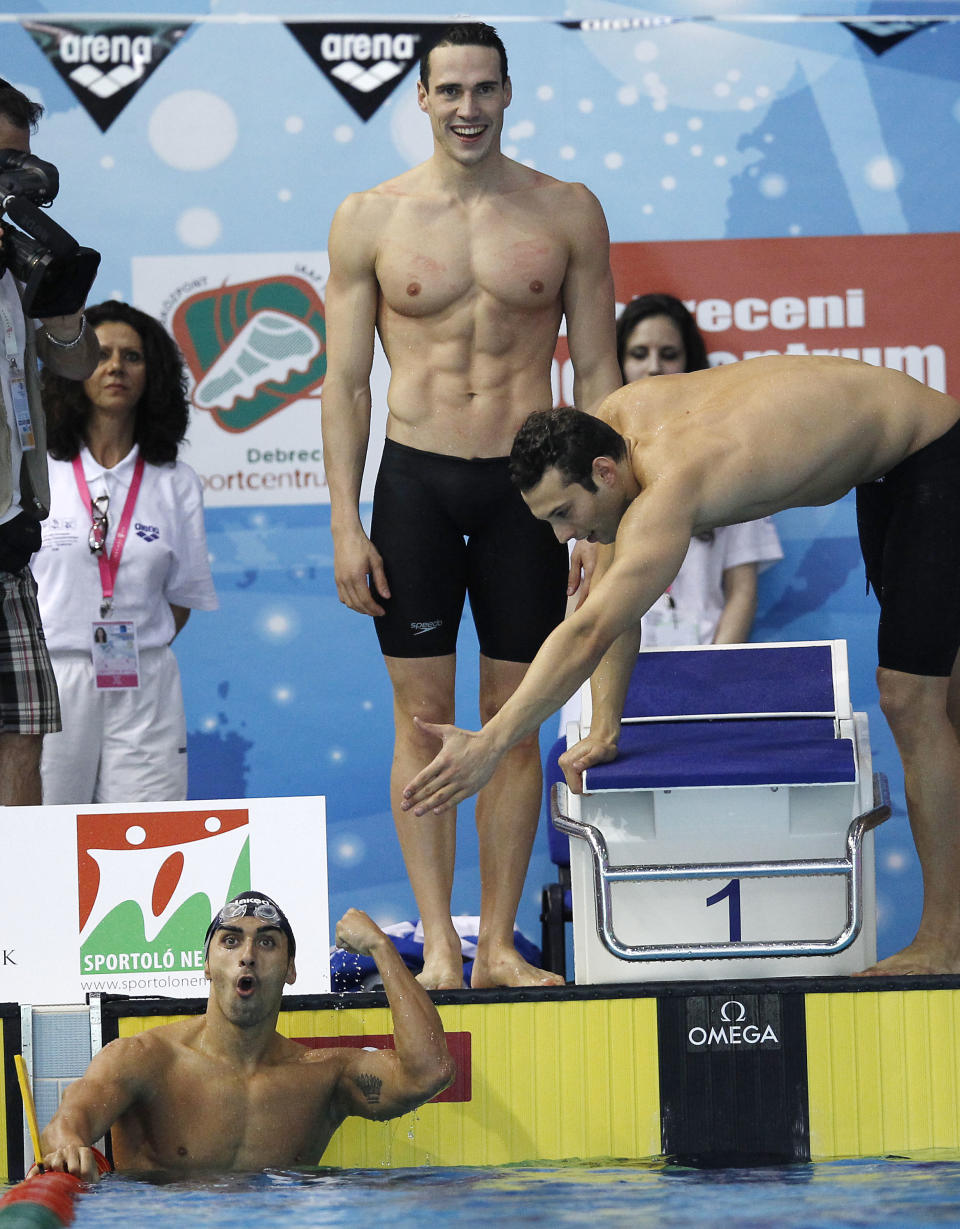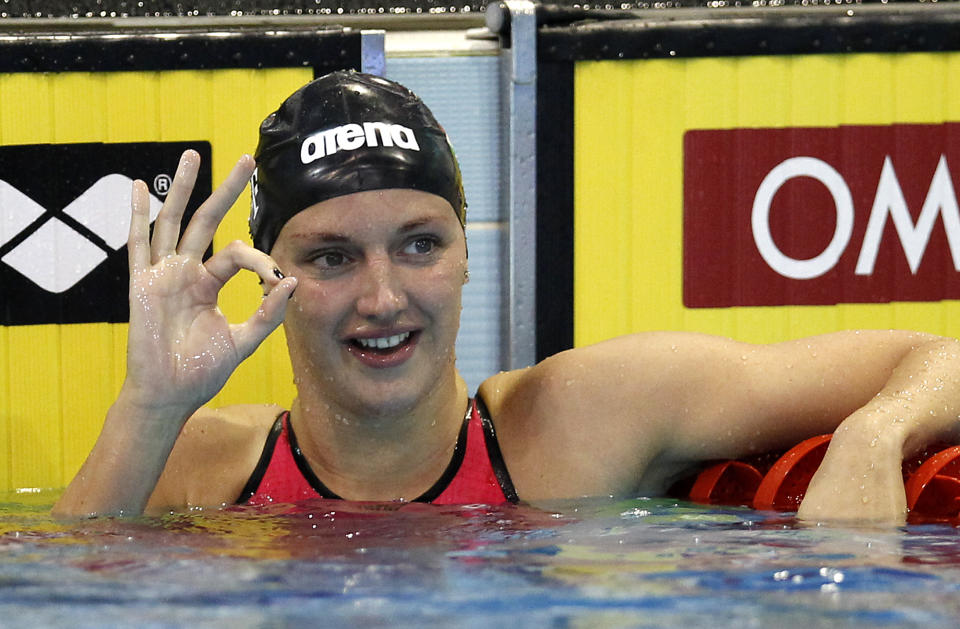More swimsuit drama heading into London Olympics
With the London Olympics less than two months away, there's more chaos in the swimsuit department.
When aquatic leaders decided to ban rubberized bodysuits three years ago, it was thought that it would put an end to the technological arms race roiling the waters. And, indeed, there's not nearly as much focus on what everyone is wearing or how many world records will be broken at these games.
"The suit does matter, it does help," said Bob Bowman, the coach of 14-time Olympic gold medalist Michael Phelps. "But it just gives them a little sharpness. It doesn't completely change them as a swimmer."
Still, mirroring the anarchy that seemingly ruled at the 2008 Beijing Games and the 2009 world championships, swimmers are now shedding suits provided by their sponsors to wear apparel perceived to be faster. Teams are jockeying to make sure their athletes have the best suits available — no matter who is their official supplier.
This time, the roles are reversed for two of the main manufacturers.
Whereas Speedo's LZR Racer was all the rage at the last Olympics, Arena's Powerskin Carbon-Pro appears to have the edge this time.
"Four years ago, the performance difference was much larger," said Giuseppe Musciacchio, Arena's general manager for brand development. "We're not talking about seconds now, but tenths can also make a difference in an Olympic race."
Speedo unveiled its 2012 products, the Fastskin3 Racing System, at elaborate presentations in November featuring Phelps in New York and Rebecca Adlington in London. Besides the suit itself, the system features wide, angular goggles that allow for peripheral vision, plus a new cap that is designed to reduce resistance in the pool even more.
But neither the suit nor the system has caught on.
"The new suit is horrible," said Netherlands coach Titus Mennen at last week's European Championship at Debrecen, Hungary. "It gets very heavy and it's difficult for the women to put it on, pulling the (straps) over their heads. Then it bunches up in the water. That's something Speedo has to work on."
Not this year. According to the rules put in place by governing body FINA in 2009, all suits being used this year had to be submitted for approval last July 1 and be on the market by the first day of this year.
So, many athletes are still wearing Speedo's 2010 suit, the LZR Racer Elite, which was introduced after FINA limited men to jammers covering only the waist to the knees, and women to suits covering shoulders to knees — both made from textiles only.
"We're swimming with the old suits," Mennen told The Associated Press. "We've asked to get new versions of the old suits by the summer, but Speedo is not eager to provide them again."
Speedo disagreed, issuing a statement to the AP insisting "the Fastskin LZR Racer Elite suit will be made available to any athlete who can and chooses to wear it during the Olympic Games."
The powerful U.S. squad allows its athletes to wear any suit they want, though the team is sponsored by Speedo. The situation is the same for three other leading teams: the Australians, the Dutch and the British, who are eager to make a big splash at their home games.
There were some suit switches at the British trials, held in March at the London Olympic pool.
"What still frustrates me is everybody is just now coming out with their suits," Britain head coach Dennis Pursley said. "Yes, it's a step in the right direction to change the rules as far as the materials and design, but the suit manufacturers wait until the 11th hour to roll their suits out, and then the athletes have to find opportunities to race in the different suits and determine which one works best for them."
When Italy's Filippo Magnini won the 100-meter freestyle at the Euros, he wore a Jaked suit with the logo blacked out. He is sponsored by Speedo.
"I don't think they really hit the mark with that suit. Nobody is using the three-part system," said Claudio Rosetto, Magnini's coach. "For the men, the suits don't make such a big difference now, but if there's a big negative effect, that's significant."
When Magnini's teammate Fabio Scozzoli won the 100 breaststroke at the Euros, he wore the 2010 Speedo.
"As long as that keeps working for me, I'll use it," Scozzoli said. "The new one compresses too much. It's heavy and it seems like it holds water."
But Speedo said Phelps and teammate Ryan Lochte, the two leading medal contenders heading into London, are using the new apparel.
"Michael and Ryan have both recently competed in the Speedo Fastskin3 Super Elite and Elite suits, Super Elite Cap and Elite goggles and we anticipate they will wear the Speedo Racing System this year," the company said in its statement. "However, some athletes who prefer the familiarity of a fully bonded and lightweight suit continue to wear the Speedo LZR Racer Elite suit."
World-record holder Jessica Hardy is among those using the 2010 suit. She hasn't had time to get used to the new Speedo goggles, either.
"The depth perception is really different and I can see more than I would like to see in them," she said. "I think I'm just going to try it later, after the summer."
The suit rule changes put in place at the beginning of 2010 set the swimming clock back several years. A staggering 43 world records were set at the '09 world championships in Rome at the height of the supersuit era, while just two were broken at last year's worlds in Shanghai — one by Lochte in the 200 individual medley and another by China's Sun Yang in the 1,500 free.
"I'm very, very happy the suit thing is not as distracting as it once was," said U.S. star Natalie Coughlin, who didn't compete in Rome but is back to go for her third Olympics.
Still, there are swimmers who complain about missing out on bonuses for breaking records, while manufacturers are clamoring for FINA to conform men's suits with the women's suits, which would allow for more sponsor space on the chest and higher prices.
"I don't see any great change coming down yet," British Swimming chief executive David Sparkes said. "I sense now with the coaches and the federations and the sponsors, the feeling is we probably just need some stability now. I don't think there will be a big move to change things. But maybe that will change after London, you just don't know."
___
AP Sports Writers Beth Harris in Irvine, Calif., and Paul Newberry in Charlotte, N.C., contributed to this report.
___
Follow Andrew Dampf on Twitter at www.twitter.com/FoosFile , Beth Harris at www.twitter.com/bethharrisap and Paul Newberry at www.twitter.com/pnewberry1963


